Research highlights
Jul 10th, 2024

Predicting the risk of invasion by broadleaf watermilfoil (Myriophyllum heterophyllum) in mainland Portugal
Broadleaf water milfoil (Myriophyllum heterophyllum) is an emerging invasive alien plant in Europe, and thus an EU priority for surveillance, monitoring, and eradication. This species is native to North America and threatens aquatic ecosystems by creating dense stands that can fill an entire water body, leading to both economic and native biodiversity losses. Although its presence in Portugal is not reported, the species is already established in several European countries, including Spain. In this study, we assessed the risk of invasion by this species in mainland Portugal by jointly considering environmentally suitable areas and the risk of human-mediated introduction. Environmental suitability was estimated using MaxEnt, whose model achieved a mean AUC=0.96±0.008 and indicated that the peaks of suitability were found mainly in temperate climate regions along central and northern coastal areas in Portugal. The risk of introduction was estimated by mapping and calculating the spatial density of aquarium stores. Jointly considering environmental suitability and risk of introduction, we observed that hotspots of risk of invasion are concentrated on the Portuguese central and northern coasts and in the Lisbon and Porto metropolitan areas. Several of these risk hotspots fall within protected areas and sites designated under the EU Habitats Directive, comprising water bodies of high significance for local vegetation and fauna. Therefore, measures must be taken to reduce this invasion risk (e.g. surveillance and monitoring efforts confirming its absence and preventing its future arrival).. The work is available in open access here. Image: Myriophyllum heterophyllum (credit: Leslie J. Mehrhoff).
Broadleaf water milfoil (Myriophyllum heterophyllum) is an emerging invasive alien plant in Europe, and thus an EU priority for surveillance, monitoring, and eradication. This species is native to North America and threatens aquatic ecosystems by creating dense stands that can fill an entire water body, leading to both economic and native biodiversity losses. Although its presence in Portugal is not reported, the species is already established in several European countries, including Spain. In this study, we assessed the risk of invasion by this species in mainland Portugal by jointly considering environmentally suitable areas and the risk of human-mediated introduction. Environmental suitability was estimated using MaxEnt, whose model achieved a mean AUC=0.96±0.008 and indicated that the peaks of suitability were found mainly in temperate climate regions along central and northern coastal areas in Portugal. The risk of introduction was estimated by mapping and calculating the spatial density of aquarium stores. Jointly considering environmental suitability and risk of introduction, we observed that hotspots of risk of invasion are concentrated on the Portuguese central and northern coasts and in the Lisbon and Porto metropolitan areas. Several of these risk hotspots fall within protected areas and sites designated under the EU Habitats Directive, comprising water bodies of high significance for local vegetation and fauna. Therefore, measures must be taken to reduce this invasion risk (e.g. surveillance and monitoring efforts confirming its absence and preventing its future arrival).. The work is available in open access here. Image: Myriophyllum heterophyllum (credit: Leslie J. Mehrhoff).
Dec 18th, 2023
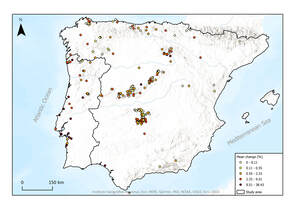
Recent land use and land cover pressures on Iberian peatlands
Iberian peatlands have been severely affected by land use and land cover (LULC) changes. Despite these pressures, some peatlands persist in the region, although their susceptibility to LULC change remains poorly understood. This study presents the most detailed and extensive distribution data for Iberian peatlands to date and analyzes the dynamics and drivers of LULC in Iberian peatlands and their surrounding areas. We compiled peatland records from various sources and used Corine Land Cover Change layers to determine LULC shifts in their surrounding areas for 1990, 2000, 2006, 2012, and 2018. Environmental and socioeconomic variables were used to create Boosted Regression Tree models explaining spatial variations in the mean percentage of changed area. Analysis of 270 peatland locations in the Iberian Peninsula revealed that forests and seminatural areas constituted over 80% of the peatland’s surroundings. Agricultural areas expanded the most, except between 2006 and 2012 when the artificial areas showed more gains. While most surrounding areas experienced an average change of 0%-9.51% of the total area, between 1990 and 2018, lowland peatlands (littoral and sublittoral) suffered more intense changes (9.51% to 38.43%). Our models showed that only elevation and agricultural area density were relevant predictors of the spatial distribution of changes. Upland Iberian peatlands showed lower susceptibility to LULC change, while lowland peatlands underwent remarkable transformations. This study substantially expands previous knowledge about the distribution and conservation needs of these ecosystems in the Iberian Peninsula, especially those in littoral and sublittoral lowlands. The work is available here.
Image: Distribution of the mean changed area, in percentage, between 1990 and 2018, of each peatland. figure3.jpg
Iberian peatlands have been severely affected by land use and land cover (LULC) changes. Despite these pressures, some peatlands persist in the region, although their susceptibility to LULC change remains poorly understood. This study presents the most detailed and extensive distribution data for Iberian peatlands to date and analyzes the dynamics and drivers of LULC in Iberian peatlands and their surrounding areas. We compiled peatland records from various sources and used Corine Land Cover Change layers to determine LULC shifts in their surrounding areas for 1990, 2000, 2006, 2012, and 2018. Environmental and socioeconomic variables were used to create Boosted Regression Tree models explaining spatial variations in the mean percentage of changed area. Analysis of 270 peatland locations in the Iberian Peninsula revealed that forests and seminatural areas constituted over 80% of the peatland’s surroundings. Agricultural areas expanded the most, except between 2006 and 2012 when the artificial areas showed more gains. While most surrounding areas experienced an average change of 0%-9.51% of the total area, between 1990 and 2018, lowland peatlands (littoral and sublittoral) suffered more intense changes (9.51% to 38.43%). Our models showed that only elevation and agricultural area density were relevant predictors of the spatial distribution of changes. Upland Iberian peatlands showed lower susceptibility to LULC change, while lowland peatlands underwent remarkable transformations. This study substantially expands previous knowledge about the distribution and conservation needs of these ecosystems in the Iberian Peninsula, especially those in littoral and sublittoral lowlands. The work is available here.
Image: Distribution of the mean changed area, in percentage, between 1990 and 2018, of each peatland. figure3.jpg
Sep 20th, 2023
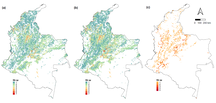
Primate extinction, the legacy of 40 years’ road expansion in Colombia
Primates are declining worldwide and rapid infrastructure expansion, particularly roads, threatens their habitat. This is particularly impactful in tropical areas with high endemic biodiversity, as is occurring with primates in Colombia. However, temporal assessments of how roads impact local biodiversity are rare. In this work, we conducted a comprehensive assessment of the exposure of Colombian primates to roads from 1970 to 2015. Using a spatially explicit and species-specific approach, we estimated the critical road density and the critical patch size primate species can withstand before going locally extinct. Then, overlapping species ranges with Colombia’s road networks over time, we mapped road expansion within each habitat and ranked species vulnerability to the impact of roads. Primates in the Andean and Caribbean regions faced the greatest exposure to road impacts, with an average 16% increase in the amount of affected habitat during the study period. Species in most need of conservation based on road exposure rankings are: Cebus versicolor, Aotus griseimembra, Ateles hybridus, Saguinus leucopus and Saguinus oedipus. The work is available here.
Image: The maps show the number of analyzed primate species that are affected by roads in Colombia, per 5x5km km grid cell under our vulnerability criteria in: (a) 1970; (b) 2015; and (c) Difference between 1970 and 2015.
Primates are declining worldwide and rapid infrastructure expansion, particularly roads, threatens their habitat. This is particularly impactful in tropical areas with high endemic biodiversity, as is occurring with primates in Colombia. However, temporal assessments of how roads impact local biodiversity are rare. In this work, we conducted a comprehensive assessment of the exposure of Colombian primates to roads from 1970 to 2015. Using a spatially explicit and species-specific approach, we estimated the critical road density and the critical patch size primate species can withstand before going locally extinct. Then, overlapping species ranges with Colombia’s road networks over time, we mapped road expansion within each habitat and ranked species vulnerability to the impact of roads. Primates in the Andean and Caribbean regions faced the greatest exposure to road impacts, with an average 16% increase in the amount of affected habitat during the study period. Species in most need of conservation based on road exposure rankings are: Cebus versicolor, Aotus griseimembra, Ateles hybridus, Saguinus leucopus and Saguinus oedipus. The work is available here.
Image: The maps show the number of analyzed primate species that are affected by roads in Colombia, per 5x5km km grid cell under our vulnerability criteria in: (a) 1970; (b) 2015; and (c) Difference between 1970 and 2015.
Aug 26th, 2023
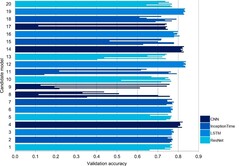
Forecasting the abundance of disease vectors with deep learning
Arboviral diseases such as dengue, Zika, chikungunya or yellow fever are a worldwide concern. The abundance of vector species plays a key role in the emergence of disease outbreaks, which highlights the importance of forecasting their numbers for preventive risk assessment. In this work, we presented a novel approach using state-of-the-art deep learning algorithms to forecast disease vector abundances. Deep learning models use time series data directly as predictors and identify the features that are most relevant from a predictive perspective. We demonstrated for the first time the application of this approach to predict short-term temporal trends in Aedes aegypti mosquito egg abundance across Madeira Island. We applied the deep learning models to predict whether, in the following week, the number of Ae. aegypti eggs would remain unchanged, or whether it would increase or decrease, considering different percentages of change. We obtained high predictive performance for all years considered (2013-2019; mean AUC = 0.92 ± 0.05 SD) and our approach performed better than classical machine learning methods. We also found that the preceding numbers of eggs was a highly informative predictor of future trends. Importantly, we used an open-source approach that can be adapted to other settings and questions. The work is freely available here.
Image: The plot shows validation accuracy for each deep learning candidate model (1-20 on the vertical axis) and test year (from top to bottom: 2019 to 2013). The best model in all years is model 12, with a DeepConvLSTM architecture.
Arboviral diseases such as dengue, Zika, chikungunya or yellow fever are a worldwide concern. The abundance of vector species plays a key role in the emergence of disease outbreaks, which highlights the importance of forecasting their numbers for preventive risk assessment. In this work, we presented a novel approach using state-of-the-art deep learning algorithms to forecast disease vector abundances. Deep learning models use time series data directly as predictors and identify the features that are most relevant from a predictive perspective. We demonstrated for the first time the application of this approach to predict short-term temporal trends in Aedes aegypti mosquito egg abundance across Madeira Island. We applied the deep learning models to predict whether, in the following week, the number of Ae. aegypti eggs would remain unchanged, or whether it would increase or decrease, considering different percentages of change. We obtained high predictive performance for all years considered (2013-2019; mean AUC = 0.92 ± 0.05 SD) and our approach performed better than classical machine learning methods. We also found that the preceding numbers of eggs was a highly informative predictor of future trends. Importantly, we used an open-source approach that can be adapted to other settings and questions. The work is freely available here.
Image: The plot shows validation accuracy for each deep learning candidate model (1-20 on the vertical axis) and test year (from top to bottom: 2019 to 2013). The best model in all years is model 12, with a DeepConvLSTM architecture.
Jun 13th, 2023
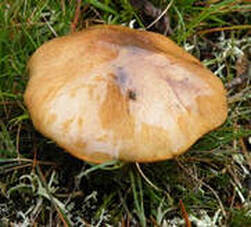
Negative and positive impacts of alien macrofungi: a global scale database
The effects of alien macrofungi have usually received little attention and are still poorly known. In a recent paper, we provide the first comprehensive global database on negative and positive impacts of alien macrofungi (i.e., ‘mushrooms’), based on which we assess i) the typology and frequency of recorded impacts; ii) the taxonomic diversity of species associated to these impacts, and iii) their geographical distribution. We observed that recorded impacts of alien macrofungi encompass a wide variety of effects on humans, native and alien plant taxa, other fungi and animal species and soil biochemistry. Besides, we also verified a broad diversity of macrofungi species for which at least one type of impact is reported, totaling 374 distinct species, suggesting that the management and prevention of these impacts requires the adoption of transnational cooperation strategies and more than species-specific measures. We also highlight that many types of impacts are likely strongly under-recorded (e.g., changes caused to local biodiversity and trophic relationships) and more research is necessary to uncover their true magnitude. The work is freely available in ResearchGate or Neobiota.
Image: Suillus luteus (L.) was one of the species with the greatest diversity of impact types from both negative and positive categories.
The effects of alien macrofungi have usually received little attention and are still poorly known. In a recent paper, we provide the first comprehensive global database on negative and positive impacts of alien macrofungi (i.e., ‘mushrooms’), based on which we assess i) the typology and frequency of recorded impacts; ii) the taxonomic diversity of species associated to these impacts, and iii) their geographical distribution. We observed that recorded impacts of alien macrofungi encompass a wide variety of effects on humans, native and alien plant taxa, other fungi and animal species and soil biochemistry. Besides, we also verified a broad diversity of macrofungi species for which at least one type of impact is reported, totaling 374 distinct species, suggesting that the management and prevention of these impacts requires the adoption of transnational cooperation strategies and more than species-specific measures. We also highlight that many types of impacts are likely strongly under-recorded (e.g., changes caused to local biodiversity and trophic relationships) and more research is necessary to uncover their true magnitude. The work is freely available in ResearchGate or Neobiota.
Image: Suillus luteus (L.) was one of the species with the greatest diversity of impact types from both negative and positive categories.
May 29th, 2023
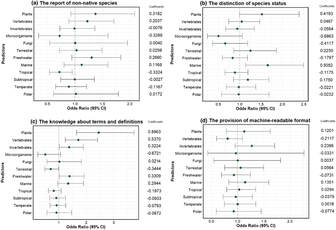
Who is reporting non-native species and how? A cross-expert assessment of practices and drivers of non-native biodiversity reporting in species regional listing
Data on the distribution of non-native species are essential for monitoring global biodiversity change and preventing biological invasions. However, these data can be challenging to identify, collect, and integrate into analytical workflows due to differences in reporting structures, storage formats, and the omission or inconsistency of relevant information and terminology. In this work, we conducted an online survey targeting authors of species regional checklists and we found:
1. that nearly half of respondents (45.5%) do not always report non-native taxa.
2. of those who report, many (44.7%) do not always differentiate them from native taxa.
3. close to half of respondents (46.4%) also view the terminology of biological invasions as an obstacle to the reporting of non-native taxa.
4. only 13.4% of respondents mention to always provide the data in automation-friendly formats or its publication in biodiversity data repositories
5. the reporting of their non-native status appears to be significantly more common among experts working in the marine realm
6. respondents with higher expertise in plants, vertebrates, invertebrates, and the freshwater environmental realm have a significant positive relationship with higher knowledge of the terms and definitions of biological invasions
The work can be found here .
Image: Results of ordinal logistic regressions, relating patterns of variation in answers and levels of expertise in distinct taxonomic groups, environmental realms and quantity of checklists published in each biome.
Data on the distribution of non-native species are essential for monitoring global biodiversity change and preventing biological invasions. However, these data can be challenging to identify, collect, and integrate into analytical workflows due to differences in reporting structures, storage formats, and the omission or inconsistency of relevant information and terminology. In this work, we conducted an online survey targeting authors of species regional checklists and we found:
1. that nearly half of respondents (45.5%) do not always report non-native taxa.
2. of those who report, many (44.7%) do not always differentiate them from native taxa.
3. close to half of respondents (46.4%) also view the terminology of biological invasions as an obstacle to the reporting of non-native taxa.
4. only 13.4% of respondents mention to always provide the data in automation-friendly formats or its publication in biodiversity data repositories
5. the reporting of their non-native status appears to be significantly more common among experts working in the marine realm
6. respondents with higher expertise in plants, vertebrates, invertebrates, and the freshwater environmental realm have a significant positive relationship with higher knowledge of the terms and definitions of biological invasions
The work can be found here .
Image: Results of ordinal logistic regressions, relating patterns of variation in answers and levels of expertise in distinct taxonomic groups, environmental realms and quantity of checklists published in each biome.
Jan 2nd, 2023
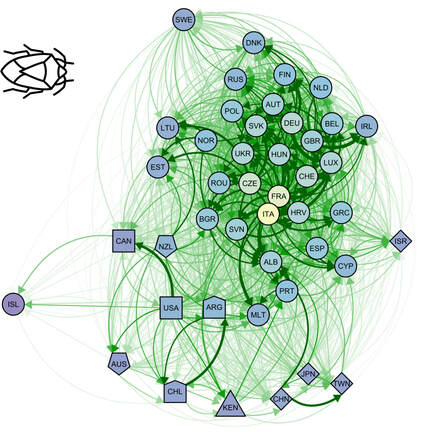
The worldwide networks of spread of recorded alien species.
In view of the large and growing number of alien species, understanding universal spread patterns common among taxa but specific to regions would considerably improve our ability to predict future dynamics of biological invasions. In this work, we show that these patterns exist and are characterized by the early presence of alien species in a few countries, playing central roles in the global trade network, followed by radiative spread into geographically close countries with similar climates. This supports a hierarchical type of spread, where some countries act as major dispersal hubs and determine global invasion routes. Targeting the countries that have emerged as hubs for the early spread of alien species may have substantial cascading effects on the global spread network of alien species, significantly reducing biological invasions.
The work can be found here (open access after first six months).
Image: Spread network of alien insects species, where it is possible, for example, to see that among european countries, Italy and France are the two countries sharing more species with other countries.
In view of the large and growing number of alien species, understanding universal spread patterns common among taxa but specific to regions would considerably improve our ability to predict future dynamics of biological invasions. In this work, we show that these patterns exist and are characterized by the early presence of alien species in a few countries, playing central roles in the global trade network, followed by radiative spread into geographically close countries with similar climates. This supports a hierarchical type of spread, where some countries act as major dispersal hubs and determine global invasion routes. Targeting the countries that have emerged as hubs for the early spread of alien species may have substantial cascading effects on the global spread network of alien species, significantly reducing biological invasions.
The work can be found here (open access after first six months).
Image: Spread network of alien insects species, where it is possible, for example, to see that among european countries, Italy and France are the two countries sharing more species with other countries.
Sep 28th, 2022

The current and future distribution of the yellow fever mosquito (Aedes aegypti) on Madeira Island
The Aedes aegypti mosquito is the main vector of several diseases of global importance, such as dengue and yellow fever. This species is currently established on the subtropical island of Madeira (Portugal) and has already been responsible for a dengue outbreak that affected over 2000 people between 2012 and 2013. To help reduce the risk of future outbreaks, local health authorities have been monitoring the species' distribution across the island, but the invasion process is still ongoing and the full extent of areas that may be colonized by this mosquito is still unknown.
In one of our recent works, we estimated the current and potential future distribution of Ae. aegypti on Madeira Island under current and future conditions, and jointly analyzed these predictions with estimates of land use suitability and human settlement conditions to provide, for the first time, a detailed assessment of the potential distribution for this species in the Island. The work is freely available from ResearchGate or PNTD.
Image: Geographical location and topography of Madeira Island.
The Aedes aegypti mosquito is the main vector of several diseases of global importance, such as dengue and yellow fever. This species is currently established on the subtropical island of Madeira (Portugal) and has already been responsible for a dengue outbreak that affected over 2000 people between 2012 and 2013. To help reduce the risk of future outbreaks, local health authorities have been monitoring the species' distribution across the island, but the invasion process is still ongoing and the full extent of areas that may be colonized by this mosquito is still unknown.
In one of our recent works, we estimated the current and potential future distribution of Ae. aegypti on Madeira Island under current and future conditions, and jointly analyzed these predictions with estimates of land use suitability and human settlement conditions to provide, for the first time, a detailed assessment of the potential distribution for this species in the Island. The work is freely available from ResearchGate or PNTD.
Image: Geographical location and topography of Madeira Island.
Aug 12th, 2022
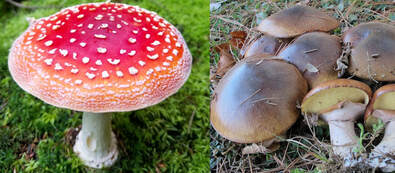
Patterns and drivers of the global diversity of non-native macrofungi
As with many other species, macrofungi (aka 'mushrooms') are being introduced into new regions of the world by human activities. In a recent work, we provide the first comprehensive examination of the distribution and temporal introduction patterns of non-native macrofungi worldwide. We identified more than 550 species ocurring outside of native ranges, particularly in Europe and in regions of the Southern Hemisphere. The numbers of new introduction records and of newly introduced species have also increased strongly in the past ~100y, suggesting that many new changes to macrofungi biogeography are likely to occur as globalisation proceeds. The work is freely available from ResearchGate or DDi.
Image: Two of the most globally widespread non-native macrofungi, Amanita muscaria (left) and Suillus luteus (right).
As with many other species, macrofungi (aka 'mushrooms') are being introduced into new regions of the world by human activities. In a recent work, we provide the first comprehensive examination of the distribution and temporal introduction patterns of non-native macrofungi worldwide. We identified more than 550 species ocurring outside of native ranges, particularly in Europe and in regions of the Southern Hemisphere. The numbers of new introduction records and of newly introduced species have also increased strongly in the past ~100y, suggesting that many new changes to macrofungi biogeography are likely to occur as globalisation proceeds. The work is freely available from ResearchGate or DDi.
Image: Two of the most globally widespread non-native macrofungi, Amanita muscaria (left) and Suillus luteus (right).
